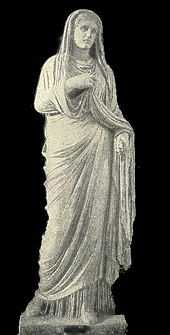Eumachia

Eumachia was the public priestess of Venus in Pompeii during the middle of the 1st century AD as well as the matron of the Concordia Augustus.[1][2] The Concordia Augustus was an imperial cult initiated by Livia, widow of Augustus, dedicated to the Divus Augustus, the deified emperor Augustus.[3]
Family history and significance
The daughter of Lucius (Eumachius), she is reported to have obtained her great wealth in her own right as a very successful matron. Of inconsequential origin, she sought a higher social status by marrying into one of the older families of Pompeii. Eumachia was also known as the matron of the fullers, an economically significant guild in Pompeii which consisted of dyers and clothing-makers. Eumachia's importance in Roman history stems from how she is seen as a good example of how a Roman woman of non-imperial descent can become involved in public affairs. She is also viewed as a model for the increasing involvement of women in politics, using the power of a public priestess for social mobility.[4]
Euergetism

Using her wealth and status, Eumachia funded the construction of a large building next to the public forum in Pompeii. This is an example of the idea of euergetism, the socio-political phenomenon of voluntary gift-giving, which exerted an influence on the wealthy people of her time period.[5]
The presumed use of this building was to serve as the headquarters for the fullers’ guild, although its exact use is uncertain. She dedicated this building, known as the Building of Eumachia, to the Concordia Augusta and to Pietas. In addition, statues of Tiberius, the emperor during her life, and Livia, his mother, were found on this inside, along with inscriptions on the outside of the building which included dedications to them. Finally, she dedicated the building to her son, Marcus Numistrius Fronto.[1]
Statue

In response to her generosity, and symbolic of her power and social status, the fullers built a statue depicting Eumachia in the veiled form of a priestess. They inscribed into its foundation a dedication.[6] The rough translation of this inscription is: "to Eumachia, daughter of Lucius, public priestess of Pompeian Venus, from the fullers."[7] See Corpus Inscriptionum Latinarum: "EVMACHIAE L F SACERD PVBL FVLLONES,” .[8]
References
- ↑ 1.0 1.1 Lefkowitz, Mary R., and Maureen B. Fant. Women's Life in Greece and Rome. London: Duckworth, 1982. 259.
- ↑ James, edited by Sharon L.; Dillon, Sheila. A companion to women in the ancient world. Chichester, West Sussex: Wiley-Blackwell. p. 405. ISBN 9781444355000.
- ↑ D'ambra, Eve. Roman Women. New York: Cambridge UP, 2007. 154-155.
- ↑ Salisbury, Joyce E. "Eumachia." Encyclopedia of Women in the Ancient World. Santa Barbara: Abc-Clio, 2001.
- ↑ Hornblower, Simon, and Antony Spawforth, eds. "Pompeii." Oxford Companion to Classical Civilization. Oxford: Oxford UP, 1998.
- ↑ Can be seen here
- ↑ Boatwright, Mary T., Daniel J. Gargola, and Richard J. Talbert. A Brief History of the Romans. New York: Oxford UP, 2006. 217.
- ↑ CIL, vol. X, no. 813; Pompeii, first century A.D.
| Wikimedia Commons has media related to Statue of Eumachia from Pompeii. |